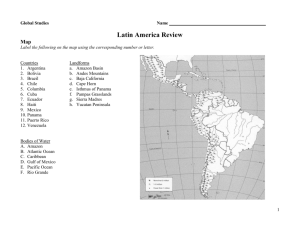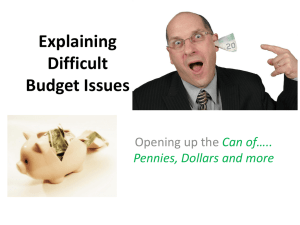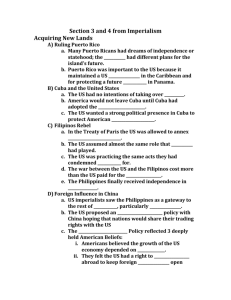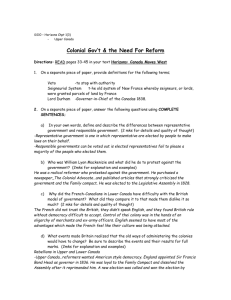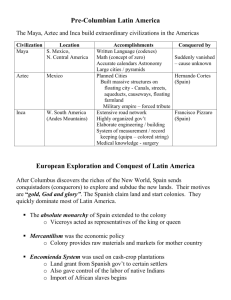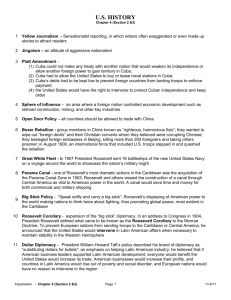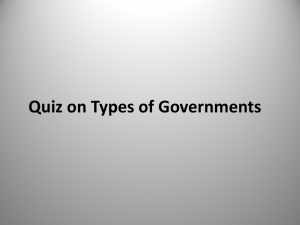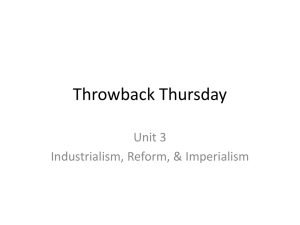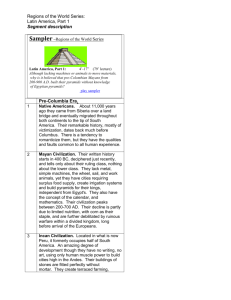Latin America and the Modern World (1945
advertisement
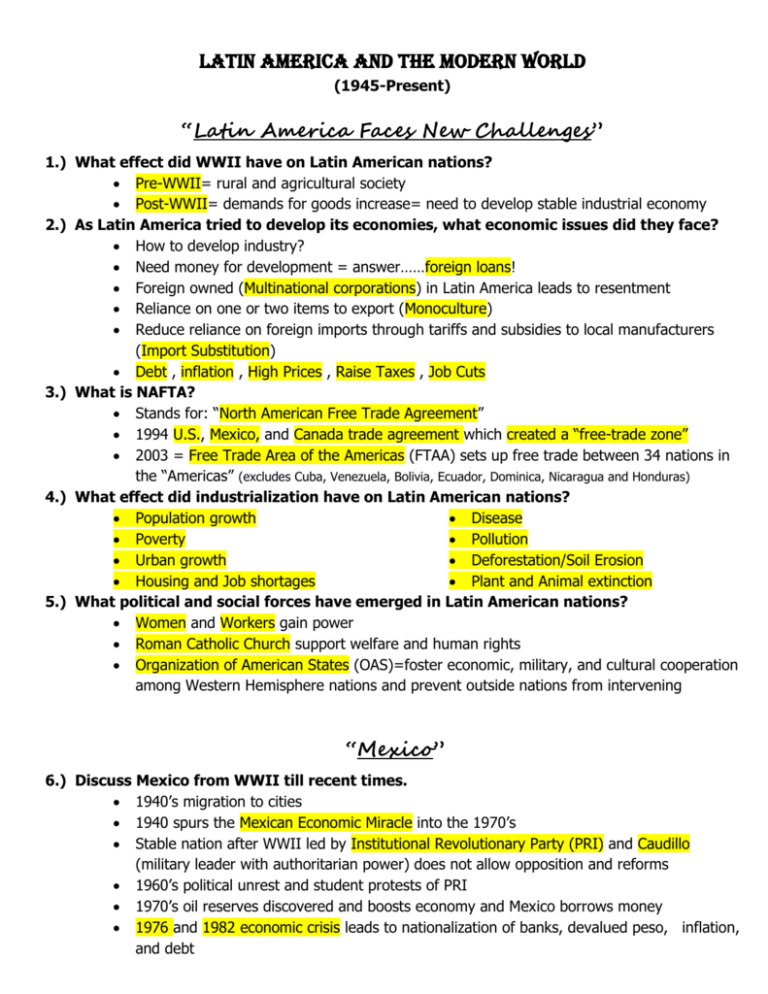
Latin America and the Modern World (1945-Present) “Latin America Faces New Challenges” 1.) What effect did WWII have on Latin American nations? Pre-WWII= rural and agricultural society Post-WWII= demands for goods increase= need to develop stable industrial economy 2.) As Latin America tried to develop its economies, what economic issues did they face? How to develop industry? Need money for development = answer……foreign loans! Foreign owned (Multinational corporations) in Latin America leads to resentment Reliance on one or two items to export (Monoculture) Reduce reliance on foreign imports through tariffs and subsidies to local manufacturers (Import Substitution) Debt , inflation , High Prices , Raise Taxes , Job Cuts 3.) What is NAFTA? Stands for: “North American Free Trade Agreement” 1994 U.S., Mexico, and Canada trade agreement which created a “free-trade zone” 2003 = Free Trade Area of the Americas (FTAA) sets up free trade between 34 nations in the “Americas” (excludes Cuba, Venezuela, Bolivia, Ecuador, Dominica, Nicaragua and Honduras) 4.) What effect did industrialization have on Latin American nations? Population growth Disease Poverty Pollution Urban growth Deforestation/Soil Erosion Housing and Job shortages Plant and Animal extinction 5.) What political and social forces have emerged in Latin American nations? Women and Workers gain power Roman Catholic Church support welfare and human rights Organization of American States (OAS)=foster economic, military, and cultural cooperation among Western Hemisphere nations and prevent outside nations from intervening “Mexico” 6.) Discuss Mexico from WWII till recent times. 1940’s migration to cities 1940 spurs the Mexican Economic Miracle into the 1970’s Stable nation after WWII led by Institutional Revolutionary Party (PRI) and Caudillo (military leader with authoritarian power) does not allow opposition and reforms 1960’s political unrest and student protests of PRI 1970’s oil reserves discovered and boosts economy and Mexico borrows money 1976 and 1982 economic crisis leads to nationalization of banks, devalued peso, inflation, and debt 1985 Mexico City earthquake, PRI mishandles reliefs efforts, lead to electoral challenges 1994 NAFTA is created between U.S., Mexico, and Canada 1995 December Mistake Economic Crisis, govt. protests, U.S. give Mexico billions in loans 1996 economy recovers 1997 non-PRI parties take control of Mexico’s Congress 2000 Vicente Fox wins presidency (first non-PRI leader since 1929) 2000 Mexico moves towards Democracy 2000’s illegal-immigration into U.S. and drug wars hurt relationship with U.S. “Central America” 7.) Examine Nicaragua in modern times. 1940’s Somoza reigns as dictator 1950’s U.S. companies pay favors to work throughout Nicaragua (logging/pesticides) 1963 Election reform allows secret ballot voting and Somoza family placed in ruling class 1960-1970 beef exports rise to all-time levels 1970’s people rise up against oppressive government and corruption Sandinistas (Marxist Revolutionary Group) lead revolution against dictator Anastasio Somoza Debayle 1979 Somoza flees, Sandinistas led by Daniel Ortega seize power and move Nicaragua towards Communism 1980’s Contras (U.S. funded revolutionary group) wage civil war with Sandinistas (Soviet/Cuba aided) 1990’s Ortega holds free elections and Violeta Barrios de Chamorro is elected leader 1990’s Nicaragua moves towards democracy, liberalize economy, Sandinistas oppose reforms and control much of government 1990’s Corruption and Inflation hurt govt. 2000’s free elections continue 2006 Daniel Ortega elected as president again after 16 years out of office 8.) Discuss El Salvador in modern times. 1940’s- 1960’s dictators rule nation authoritarian governments employed political repression and limited reform 1969, El Salvador invaded Honduras in the short Football War 1970’s revolutionaries led by José Napoleón Duarte protest govt. 1979 violent civil war = Salvadoran Armed Forces (ESAF) supported by U.S. vs. Farabundo Martí National Liberation Front (FMLN) supprted by Soviets and Cuba 1992 Chapultepec Peace Accords marked the end of the civil war 1990’s two political parties vie for power= ARENA and FMLN 2000’s high crime and poor economy 2009 FMLN candidate wins presidency 9.) Analyze Panama in modern times. 1940’s and 1950’s Panama is a republic 1950’s Panama’s military begins to challenge govt. 1964 Martyrs' Day riots against U.S. occupation of the Panama Canal Zone 1968 Panama’s military coup establishes military dictatorship led by Omar Torrijos 1977, the Torrijos-Carter Treaties signed transferring Panama Canal to Panama in 1999 1981 Torrijos killed in plane crash and Manuel Noriega new dictator 1980’s U.S. and Panama relations strained due to drug trafficking into U.S. from Panama 1987 U.S. freezes economic and military aide to Panama 1989 U.S. Invasion of Panama, arrests Noriega (sentenced to 40 years) 1989 election, Guillermo Endara, was sworn in as president of Panama 1990’s move towards democracy but economy in bad shape 1999 first women president elected and U.S. turns over Panama Canal 2000’s economic investment boosts economy and drug trafficking fight is successful 10.) How have Central American nations moved towards democracy in recent times. ~summarize notes from above Central American nations~ “The Caribbean” 11.) Discuss Cuba from the end of WWII, through the Cold War, and into modern times. 1940 Cuba holds free and fair elections; Fulgencio Batista is elected president 1940’s Cuba faces corruption and organized crime 1944 Cuban people elected Dr. Ramón Grau San Martín 1952 Fulgencio Batista seizes government in bloodless coup and rules as dictator 1950’s Cuba’s economy grows 1956 Cuban Revolution begins, led by Fidel Castro, Raul Castro, and Che Guevara 1959 Batista flees; Castro seizes control of Cuba; turns Cuba to Communism; rid Cuba of American influence; upper and middle class flee Cuba 1961 Bay of Pigs Invasion fails; America embarrassed; Cuba draws closer to Soviets 1962 Cuban Missile Crisis; U.S. trade embargo 1963 U.S. bans travel and financial transactions with Cuba 1960’s Castro aides communist revolutions in Dominican Republic, Nicaragua, Angola, and Ethiopia 1960’s-1989 embargo causes economic problems, food shortages, civil unrest, and dependence on Soviet aide 1990’s economic reforms lead to economic recovery 2003 Castro cracks down on journalists and dissidents 2006 Castro hospitalized 2007 Raul Castro becomes acting president 2008 Fidel Castro steps down as president; Raul Castro permanent president of Cuba 12.) Investigate Puerto Rico from WWII till modern times. 1947 U.S. grants self government 1948 Luis Munoz becomes first governor 1950 constitution of Puerto Rico is written 1952 becomes a commonwealth 1950’s Operation Bootstrap = economic shift from agrarian to industrial society 1950’s and 1960’s= thriving economy 1970’s and 1980’s= economy slows, people move to U.S. for jobs 1993 and 1998 Puerto Rico votes to remain commonwealth 2000’s major tourist destination; leading pharmaceutical and manufacturing center; struggle to define its political status; remains a territory of the U.S. 13.) Examine the history of the Dominican Republic in modern times. 1930-1961 ruled by dictator Rafael Trujillo 1940’s has largest military in Latin America (21% spent on military) 1950’s economic problems due to overspending 1960 economic sanctions imposed by OAS 1961 Trujillo assassinated 1962 Juan Bosch elected democratically 1963 military coup overthrows Bosch; military 3 party junta installed 1965 U.S. sends military to aide in preventing attempted communist overthrow 1966 new constitution written and democracy spreads 1970’s and 1980’s= politically stable, economy depends on sugar exports, tourism, and light industry Early 1990’s= economic recession, unemployment, inflation, and energy crisis Mid 1990’s= economy improves, tourism rises, and inflation down but poverty high (60%) 2000’s inflation rises and falls, poverty still high, immigration to U.S., aided in U.S. Invasion of Iraq in 2003, democratic elections 14.) Describe Haiti’s history in the modern world since WWII. 1930-1946 democracy 1946 military coup establishes military junta 1950 military coup 1956 general strike; leader resigns 1957 Dr. François Duvalier (aka Papa Doc) elected President 1960’s authoritarian rule= emigration of educated people; economic & social problems 1961 U.S. cuts aided due to government corruption 1971 Jean-Claude Duvalier (aka Baby Doc) succeeds as president; U.S. restores aide 1970’s economic and political condition continued to decline 1980’s extreme poverty, corruption, and disease (AIDS, Swine Virus) 1986 citizen rebellion, military forces Duvalier to resign 1988 civilian government elected but military coup follows 1990 Jean-Bertrand Aristide elected president 1991 rebellion causes Aristide to flee 1994 U.S. intervention allows Aristide to return 1995 Rene Preval elected president 2000 Aristide elected president a second time 2004 Aristide forced to resign due to corruption and embezzlement 2006 Rene Preval re-elected 2000’s poverty, crime, corruption, and protests 2010 earthquake kills an estimated 200,000 to 300,000 “South America” 15.) Describe the history of Brazil in the modern world since WWII. 1945 = Dictator Getulio Vargas removed from power by army 1945-1964= democracy established and economic boom 1950 = Getulio Vargas elected president 1954 = military coup removes Vargas 1961-1964 = economic problems; high inflation & industrialization slowed 1964 = military overthrows President Goulart, establishes military dictatorship 1964-1980 = Brazilian Miracle= economic boom 1964-1985 = civil rights and protests suppressed and political parties banned 1985 = Tancredo Neves elected president and nations returns to democratic civilian rule 1990’s = privatization of companies and move to free market 1998 = economic crisis and recession 2000’s= unequal distribution of wealth, social reforms, accusations of corruption 16.) Analyze the history of Argentina in the modern world since WWII. 1943 = military coup forces resignation of President Castillo; establishes dictatorship 1946 = Juan Peron becomes president, Eva Peron (wife) advises & is loved by the people 1948-1951 = high government spending, high inflation, suppressed opponents 1952 = Eva Peron dies of cancer, Juan’s popularity falls 1955 = military coup overthrows Juan Peron 1950’s and 1960’s = frequent governments coups; political and economic problems Early 1970’s = terrorist campaigns carry out by guerilla fighters from both sides 1973 = Juan Peron re-elected president w/wife Isabel as Vice President 1974 = Juan Peron dies, Isabel becomes first women president of Argentina 1976 = Isabel Peron is overthrown by the military; military controls govt. again 1976-1983 = military government carries out “dirty war” to eliminate terrorists and anyone who spoke out against the government; economic issues result 1982 = Invasion of the Falkland Islands (owned by Great Britain); Britain wins in embarrassing Argentinean military defeat 1983 = free elections held; Raul Alfonsin elected president; brings those responsible for “dirty war” to trial, economy suffers during his reign 1989 = Carl Menem elected president; economic reforms & military pardons bring stability 1995 = Menem re-elected to president; economic growth continues 1999 = Fernando de la Rua elected president; debt leads to worsening economy 1999-2003 = Economic Crisis leads to inflation, unemployment, poverty, and riots 2003-Present =“presidential marriage” (husband elected then wife elected); economic growth with inflation 17.) Discuss the history of Peru in the modern world since WWII. 1940’s-1970 = rotation between democratic and military governments 1950’s-1970’s = inflation, unemployment, poverty, and debt 1980’s = economic depression and drug trafficking 1980’s = terrorist campaigns against government by Shining Path and Tupac Amaru Revolutionary Movement (MRTA) 1990 = Alberto Fujimori elected president; economic growth and lower terrorist attacks 1995 = Fujimori wins re-election 1996 = economy slows; MRTA invades Japanese Embassy (hostage crisis) 1997 = hostage crisis ends; Fujimori’s popularity rises 2000 = Fujimori flees country due to corruption; arrested for crimes against humanity 2000’s = economic growth; terrorist still active 18.) Examine the history of Colombia in the modern world since WWII. 1945-1957 = democratic and military governments 1945-1957 = La Violencia (the violence) fighting between political groups 1957 = coalition government formed; rotate presidency 1970 = stable economy and model for Latin America 1970’s = Drug Era begins (drug production, drug trade, drug cartels, and violence) 1980’s = war on drugs begins 1990’s = drug wars and violence continues 19.) Describe the history of Chile in the modern world since WWII. 1940’s and 1950’s = model for a stable democracy 1960’s = stable democracy with social reforms 1970 = socialist candidate Salvador Allende elected as president; nationalized major industries and printed more money 1972 = economic decline with high inflation 1973 = military coup overthrows and kills Allende 1973 = military coup leader, Augusto Pinochet becomes president, rules as dictator 1973-1980 = human rights violations, new constitution, reduced civil liberties, outlawed political parties, dissolved legislature, free market economy, lower inflation but high unemployment 1980’s = foreign investment boosts economy to prosperity by late 1980’s 1988 = plebiscite votes for Pinochet not to stay in power; choose democracy 1989 = Patricio Aylwin Azocar elected president; Pinochet remains army leader 1990’s = economic prosperity; a top economy in Latin America 2000 = socialist Ricardo Lagos Escobar elected president 2000’s = free trade agreements with EU, China, Japan, India, and Latin American nations; growing and stable economy 2000-2006 = Pinochet arrested 4 times for human rights violations & corruption; dies 2006 20.) Who is Ernesto “Che” Guevara and why is he important to Latin America? Where is he from? Argentina Who was he? Marxist revolutionary, physician, author, intellectual, guerrilla leader, diplomat and military theorist How did he become involved in Latin America? Traveled throughout Latin America both as a medical student and on motorcycle tour and witnessed poverty and discrimination What event was he involved? Fought Bay of Pigs Invasion for Cuba, trained Cuban military, Cuban diplomat, gave speech in Algeria, welcomed by Mao, wrote a manual on guerilla warfare, aided in 1965 Congo civil war, advised Mozambique on independence movement, aided Bolivian guerilla force against govt. in 1966
